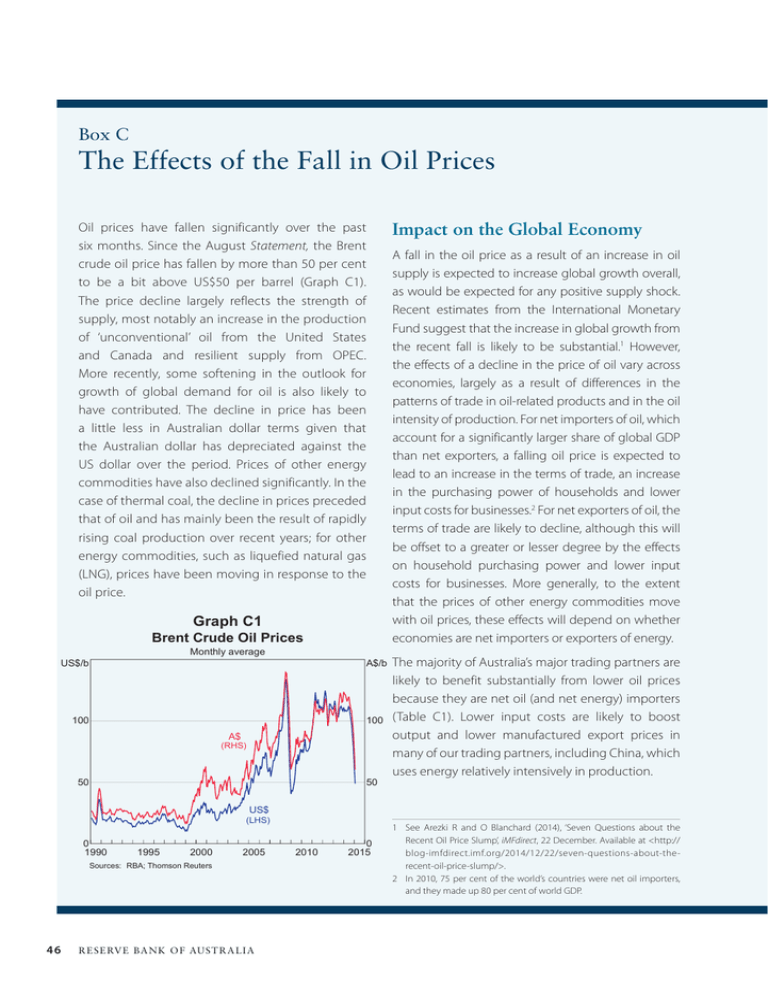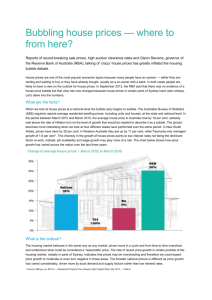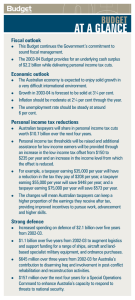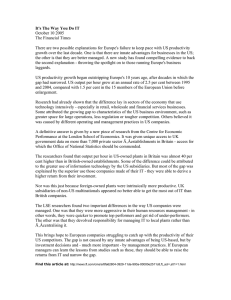The Effects of the Fall in Oil Prices Box C
advertisement

Box C The Effects of the Fall in Oil Prices Oil prices have fallen significantly over the past six months. Since the August Statement, the Brent crude oil price has fallen by more than 50 per cent to be a bit above US$50 per barrel (Graph C1). The price decline largely reflects the strength of supply, most notably an increase in the production of ‘unconventional’ oil from the United States and Canada and resilient supply from OPEC. More recently, some softening in the outlook for growth of global demand for oil is also likely to have contributed. The decline in price has been a little less in Australian dollar terms given that the Australian dollar has depreciated against the US dollar over the period. Prices of other energy commodities have also declined significantly. In the case of thermal coal, the decline in prices preceded that of oil and has mainly been the result of rapidly rising coal production over recent years; for other energy commodities, such as liquefied natural gas (LNG), prices have been moving in response to the oil price. Graph C1 Brent Crude Oil Prices Monthly average US$/b A$/b 100 100 A$ (RHS) 50 50 Impact on the Global Economy A fall in the oil price as a result of an increase in oil supply is expected to increase global growth overall, as would be expected for any positive supply shock. Recent estimates from the International Monetary Fund suggest that the increase in global growth from the recent fall is likely to be substantial.1 However, the effects of a decline in the price of oil vary across economies, largely as a result of differences in the patterns of trade in oil-related products and in the oil intensity of production. For net importers of oil, which account for a significantly larger share of global GDP than net exporters, a falling oil price is expected to lead to an increase in the terms of trade, an increase in the purchasing power of households and lower input costs for businesses.2 For net exporters of oil, the terms of trade are likely to decline, although this will be offset to a greater or lesser degree by the effects on household purchasing power and lower input costs for businesses. More generally, to the extent that the prices of other energy commodities move with oil prices, these effects will depend on whether economies are net importers or exporters of energy. The majority of Australia’s major trading partners are likely to benefit substantially from lower oil prices because they are net oil (and net energy) importers (Table C1). Lower input costs are likely to boost output and lower manufactured export prices in many of our trading partners, including China, which uses energy relatively intensively in production. US$ (LHS) 0 1990 1995 2000 2005 Sources: RBA; Thomson Reuters 46 R ES ERV E BA NK OF AUS T RA L I A 2010 0 2015 1 See Arezki R and O Blanchard (2014), ‘Seven Questions about the Recent Oil Price Slump’, iMFdirect, 22 December. Available at <http:// blog-imfdirect.imf.org/2014/12/22/seven-questions-about-therecent-oil-price-slump/>. 2 In 2010, 75 per cent of the world’s countries were net oil importers, and they made up 80 per cent of world GDP. Table C1: World Energy Trade Balances and Energy Use(a) Net Oil Imports(b) Oil intensity of GDP(c) Net Energy Imports(d) Energy intensity of GDP(d) Share of oil Consumption PPP-weighted Share of energy Consumption PPP-weighted Per cent Index, world average =100 Per cent Index, world average =100 United States 27 128 15 101 Euro area 91 88 60 69 83 High-income Asian economies(e) 101 133 87 Middle-income Asian economies(f ) 37 86 –29 79 China 56 70 11 146 India 77 58 28 91 Major trading partners(g) 65 104 33 109 Australia 51 115 –135 100 (a)The consumption and intensity measures capture oil or energy used as an input into the production of goods and services (including fuel used by households); they do not include exports of raw energy materials (b)Volume of net imports of crude and refined oil products as a share of petroleum consumption; monthly 2014 data for the United States (to November), annual 2012 data for other OECD countries and annual 2010 data otherwise (c)2013 data (d)2012 data for Australia and the United States, 2011 data otherwise (e)Hong Kong, Japan, Singapore and South Korea (f )Indonesia, Malaysia, Philippines and Thailand (g)Aggregated using Australia’s export shares Sources: ABS; EIA; IMF; RBA; World Bank Impact on the Australian Economy The decline in oil prices is expected to have a positive effect on overall growth of the Australian economy. As a net importer of oil, a falling oil price would be expected to lead to an increase in Australia’s terms of trade and in the purchasing power of national income (Table C2). This is expected to be offset to some extent by falling prices for LNG, which are linked to the oil price, albeit with a lag. This offsetting effect is small in the near term but is expected to grow as Australian LNG exports increase in importance. The prices for some other energy exports, such as thermal coal, do not appear to be moving as closely with oil prices as they have in previous episodes, suggesting that this potential linkage is not likely to lead to a further decline in Australia’s terms of trade. Although the oil intensity of production has been declining in Australia for many decades (and in most other advanced economies), oil is still an important input into the production of many goods and services, particularly in industries such as mining, transportation and some parts of manufacturing; lower oil prices will lead to lower costs of production in these industries. Oil is also an important part of the household sector’s consumption basket. Petrol prices have fallen by around 30 per cent since July 2014, which suggests that most of the price decline has been passed through to final prices (given that oil accounts for around 50 per cent of the final price of fuel). Assuming no change in the quantity of fuel consumed, the fall in the price of petrol and other automotive fuel is estimated to have increased real household disposable income by ¼ per cent S TATE ME N T O N MO N E TARY P O L ICY | F E B R UA R Y 2 0 1 5 47 Table C2: Australia’s Energy Trade Balance Per cent of nominal GDP Oil exports Oil imports Net oil position 1990–1999 2000–2009 2010–2013 September quarter 2014 0.5 0.9 0.8 0.7 0.8 1.8 2.4 2.6 –0.2 –0.9 –1.6 –1.9 Coal exports 1.5 2.2 2.9 2.3 Gas exports 0.3 0.6 0.9 1.1 Net energy position 1.6 1.9 2.2 1.4 Source: ABS over the six months to the December quarter, and is expected to increase real income by a further ½ per cent in the March quarter. These effects will be partly offset by the loss of income to Australian residents from the lower prices received for production of energy products. basket is around 3½ per cent, so the decline in its price has reduced headline CPI inflation by around ¼ percentage point over the six months to the December quarter, and is likely to subtract another ½ percentage point from inflation in the March quarter based on current oil prices. Other effects on income and output are likely to be small at this stage. The fall in the oil price is expected to reduce oil and gas exploration activity, although this accounts for less than 2 per cent of total investment activity. Recent company announcements have also identified the potential for sizeable cuts to capital expenditure by oil and gas producers, although the spending on large-scale LNG projects already underway is likely to continue largely as planned. Any effects on the consolidated fiscal balance are also likely to be relatively minor because the fuel excise is based on the quantity of petrol sold rather than its value, and revenue from oil and LNG production is currently a small share of total revenue. Moreover, this is likely to be offset to some extent by revenue from higher profits made by businesses that use oil as an input into production. The effects on the consolidated fiscal balance, however, are expected to be larger in the future as LNG production ramps up. In addition, changes in oil prices may have an indirect effect on a broader range of consumer prices through their effects on the cost of production. The size and timing of these indirect effects are difficult to determine. Input-output tables suggest that oil accounts for between 2 and 3 per cent of the prices of non-fuel items in the CPI, which implies that the indirect effect on the level of the CPI of the recent oil price movements could be as large as 1 per cent if it was fully passed through to all of these prices. In practice, however, movements in oil prices are partly absorbed into margins and any pass-through tends to occur over a very long period. Working in the other direction, the boost to real incomes will tend to increase aggregate demand and place upward pressure on prices. Partly because of these issues, econometric estimates of the effect of oil on measures of underlying inflation have been found to be quite imprecise.3 R The main effect on inflation of the decline in the oil price will occur through reductions in the price of automotive fuel. Automotive fuel’s weight in the CPI 48 R ES ERV E BA NK OF AUS T RA L I A 3 See Norman D and A Richards (2010), ‘Modelling Inflation in Australia’, RBA Research Discussion Paper No 2010-03.





